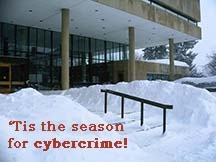News & Updates
Information Security: Suggestions for Safe Shopping This Holiday Season
By Dave Smallen and GreyCastle Security
December 16, 2015

The Season of Scams
The holidays are one of the busiest times of the year not only for consumers and retailers, but scammers as well. Every year from holiday e-cards and fake shipping receipts, to charity phishing emails and flash sales, cybercriminals try to take advantage of unsuspecting individuals. So why during the season of giving is there so much taking? Generally speaking, the increase in customer transactions and decrease in attention to detail makes the holidays ripe with opportunity when it comes to cybercrime. Follow these tips to keep your holidays happy:
1. Never provide personal information over the phone or email.
2. Don't open attachments from unknown recipients.
3. Hover over links in messages before you click on them to confirm they are from a trusted source.
4. If the deal looks too good to be true, it probably is.
Safe Shopping
In the frenzy of purchasing the hottest gift or scoring the biggest savings, we tend to forget that security should be at the top of all our wish lists. Stay secure this holiday with these shopping tips:
1. Only shop at reputable online retailers.
2. Use your credit card instead of your debit card - your credit card offers more protection if it's compromised.
3. Check out as a guest if possible - why store information online if you don't have to?
4. Check for HTTPs, the lock icon and safe shopping certificates before providing sensitive information.
5. Check your bank and credit card statements regularly!
Cashing in on the Holidays
Holiday spending have you short on cash? Follow this 10 step method for safe ATM cash withdrawals.
1. Select an ATM at a bank, in a well-lit area. Do not use ATMs in hotels, convenience stores, malls or remote areas. Make your ATM trips during the day during high traffic periods.
2. If access to the ATM requires unlocking a door with a card, use a different card than what you're about to use at the ATM. Any card with a magnetic stripe will work - use your library card or something with no value.
3. Before swiping or inserting your card - check the ATM. Wiggle the card reader and the pin pad - they should not move at all. Look for anything else that looks out of place, like attachments, unidentified boxes or cameras or other modifications.
4. Insert or swipe your card. Use your hand to cover the keypad when you enter your PIN. The idea is to block visibility by people behind you or cameras near the ATM.
5. Make sure your PIN is random - not your birthday or anything else you’ve posted on social media. Change it once per year, at a minimum.
6. Plan your transaction. Know what you want before you get there so you don't have to waste time at the ATM. Avoid multiple, time-consuming withdrawals that could keep you there longer than necessary.
7. Don't count your money at the ATM. Even if there is an error you can't do anything about it there anyway. Check your surroundings and maintain situational awareness. Move with a purpose.
8. Report any problems to the bank that owns the ATM.
9. Check your bank statement - it should match your receipts and ATM activity.
10. Remember that gas pumps, car washes and other payment devices are just as vulnerable to compromise as ATMS! Use the same tips to stay safe as these locations as well.

